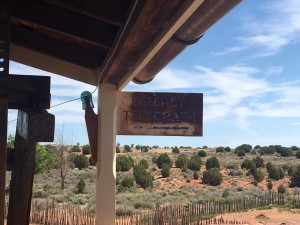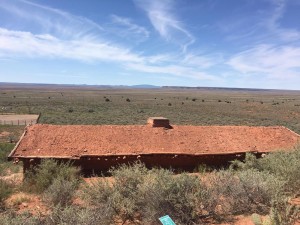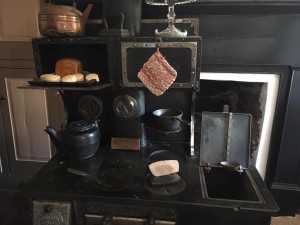
PIPE SPRING NATIONAL MONUMENT, Ariz. – Imagine a place where the grass once grew stirrup high and sunflowers graced the landscape as far as the eye could see. Imagine a bustling fort where famed explorer John Wesley Powell would stop for supplies, where 40 pounds of butter a day was churned and where Brigham Young — then-prophet of The Church of Jesus Christ of Latter-day Saints — would send clandestine messages to the telegraph office. And imagine a spring that created a crossroads where explorers, Native Americans and Mormon pioneers all depended on its life-giving waters.

Standing on the Ridge Trail at Pipe Spring National Monument in Arizona, looking across the vast desertscape that exists now, it is difficult to imagine what life must have been like in the late 1800s at this western outpost. Each day, 80-100 head of cattle needed milking, a telegraph office had to be staffed 24/7 so as not to miss a single message and 60 pounds of cheese had to be made.
Located on Arizona state Route 389 approximately 45 miles east of Hurricane and 15 miles west of Fredonia, Arizona, Pipe Spring National Monument is a small historical site operated by the National Park Service.
Though smaller in grandeur than its nearby national park siblings of Zion and the Grand Canyon, Pipe Spring has a stunning beauty and intriguing history. At just over an hour’s drive from St. George, it is the perfect distance for a “staycation” (near-home vacation) or an unique stop for travelers en route to the Grand Canyon, Kanab or Lake Powell.
Adventure at a Glance
At the Pipe Spring National Monument and Kaibab Band of Paiute Indians Visitor Center, guests can learn about the history of the Kaibab Paiutes and how they interacted with other tribes and cultures, including the white Mormon settlers who came to the area. Guests can also get a glimpse into the life and customs of modern-day Paiutes.
The grounds at Pipe Spring National Monument offer visitors an insightful look into life in the harsh but beautiful desert landscape these pioneers called their home. Visitors can walk around the property and visit the livestock, see the cabins, visit the orchard or hike on the half-mile Ridge Trail, which offers sweeping views of the monument and desert stretching south toward Mt. Trumbull and the Toroweap area of the Grand Canyon.

Hikers on the Ridge Trail will also learn about the desert flora and its many uses in the lives of the Mormon settlers and Kaibab Paiutes.
A highlight of the trip is a ranger-guided tour of “Winsor Castle,” the fort that acted as a home, tithing ranch, telegraph office, butter- and cheese-making hub and safety net for the pioneers.
On the tour, guests learn about the daily lives of the pioneer settlers and their interactions with the Native Americans and the United States government as they sent surveyors and explorers such as John Wesley Powell into the area.
During the cooler hours of the summer months, rangers offer guided walks, talks and demonstrations of pioneer and Native American crafts.
Know before you go
Pipe Spring National Monument is a fee area. Entry to the monument is $7 per person for a seven-day pass, which includes a $2.10 tribal-use fee. Holders of the America The Beautiful-Interagency Annual Pass, Senior Pass or Access Pass are admitted free, along with up to three companions. Passes can be purchased at Pipe Spring.

Children 15 and under are admitted free.
Pipe Spring National Monument operates on Mountain Standard Time year round. Hours of operation and tours vary during the summer and winter season.
In the summer season — May-August — the monument grounds and visitor center/museum are open from 8 a.m. to 5 p.m. Guided tours of Winsor Castle are offered on the hour between 9 a.m. and 4 p.m. Walks, talks and demonstrations are offered in the morning hours.
In the winter season — September-April — the monument grounds and visitor center/museum are open from 8:30 a.m. to 4:30 p.m. Guided tours of Winsor Castle are offered as needed on the hour between 9 a.m. and 3 p.m.
Pipe Spring National Monument is closed on Thanksgiving, Christmas and New Year’s Day.
- Take Interstate 15 north to Exit 16 onto state Route 9 toward Hurricane
- Turn right on 100 East in Hurricane
- Turn left onto state Route 59 East toward Hildale
- Continue east; road name changes to Arizona state Route 389 at the Utah/Arizona state line
- Pipe Spring National Monument is approximately 45 miles from Hurricane
- Turn left off Arizona SR-389 at the brown sign marking Pipe Spring National Monument
Guests based in St. George, Hurricane or any of the nearby cities can make a grand loop following SR-59/Arizona SR-389 east to Pipe Springs, continuing to Highway 89 and the cities of Fredonia, Arizona and Kanab, following Highway 89 north to Mt. Carmel Junction and then heading east on SR-9 to the east entrance of Zion National Park (park fees apply), then returning home via SR-9 through Springdale, Rockville, Virgin and LaVerkin.
Click on photo to enlarge it, then use your left-right arrow keys to cycle through the gallery.

Guest can see longhorn cattle at Pipe Spring National Monument, Arizona, April 24, 2016 | Photo by Hollie Reina, St. George News

Views from the Ridge Trail looking southwest toward Mt. Trumbull in the distance. In the 1800s grass grew to stirrup height across the land, Pipe Spring National Monument, Arizona, April 24, 2016 | Photo by Hollie Reina, St. George News

Havana Reina visits with the livestock at Pipe Spring National Monument, Arizona, April 24, 2016 | Photo by Hollie Reina, St. George News

Take a ranger-guided tour of the fort known as "Winsor Castle" at Pipe Spring National Monument, Arizona, April 24, 2016 | Photo by Hollie Reina, St. George News

Take a ranger-guided tour to see the interior of "Winsor Castle," a fort at Pipe Spring National Monument, Arizona, April 24, 2016 | Photo by Hollie Reina, St. George News

A section of "Winsor Castle" was used as a telegraph office, Pipe Spring National Monument, Arizona, April 24, 2016 | Photo by Hollie Reina, St. George News

Take a ranger-guided tour of the fort known as "Winsor Castle" at Pipe Spring National Monument, Arizona, April 24, 2016 | Photo by Hollie Reina, St. George News

Take a ranger-guided tour to see the interior of "Winsor Castle," a fort at Pipe Spring National Monument, Arizona, April 24, 2016 | Photo by Hollie Reina, St. George News

A section of "Winsor Castle" was used as a telegraph office, Pipe Spring National Monument, Arizona, April 24, 2016 | Photo by Hollie Reina, St. George News

The water from Pipe Spring National Monument created a crossroads where explorers, Native Americans and Mormon pioneers met. Learn about Native American culture at Pipe Spring National Monument, Arizona, April 24, 2016 | Photo by Hollie Reina, St. George News

Take a ranger-guided tour to see the interior of "Winsor Castle," a fort at Pipe Spring National Monument, Arizona, April 24, 2016 | Photo by Hollie Reina, St. George News

Take a ranger-guided tour to see the interior of "Winsor Castle," a fort at Pipe Spring National Monument, Arizona, April 24, 2016 | Photo by Hollie Reina, St. George News

A table displays tools used during the late 1800s at "Winsor Castle," Pipe Springs National Monument, Arizona, April 24, 2016 | Photo by Hollie Reina, St. George News

The water from Pipe Spring National Monument created a crossroads where explorers, Native Americans and Mormon pioneers met. Learn about Native American culture at Pipe Spring National Monument, Arizona, April 24, 2016 | Photo by Hollie Reina, St. George News

A baby cradle with homemade dolls invites guests to imagine daily life in the "Winsor Castle" at Pipe Spring National Monument, Arizona, April 24, 2016 | Photo by Hollie Reina, St. George News

See desert plants and learn of their uses on the Ridge Trail at Pipe Spring National Monument, Arizona, April 24, 2016 | Photo by Hollie Reina, St. George News

A sign offers historical information about the area at Pipe Spring National Monument, Arizona, April 24, 2016 | Photo by Hollie Reina, St. George News
Resources
- Pipe Spring National Monument | Website
Email: [email protected]
Twitter: @STGnews
Copyright St. George News, SaintGeorgeUtah.com LLC, 2016, all rights reserved.

